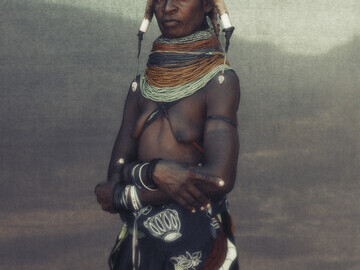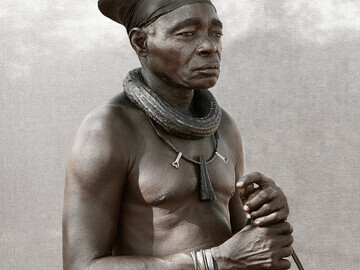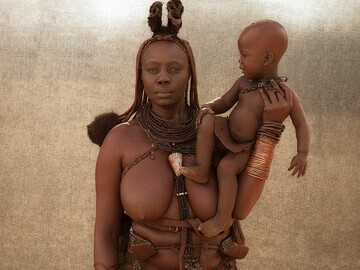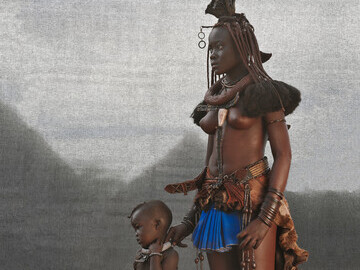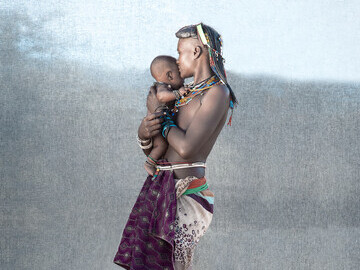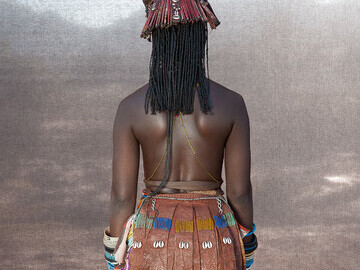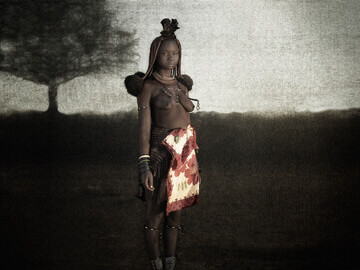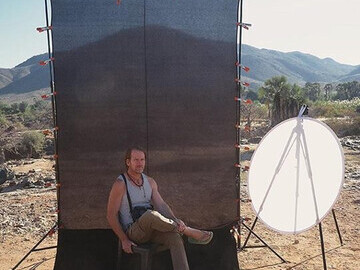The Vanishing World of Africa's Last Tribes Captured by Award Winning Photographer.
‘ I doubt what I have captured in Confluence will still be present in any genuine cultural context within twenty years which made the documentation of
British photographer, Christopher Rimmer presents the last tribes of Africa in a breath taking series of large-scale photographic portraits.
Art Expo, New York, 2019 was abuzz with excitement in April following the official launch of Christopher Rimmer’s latest body of work, Confluence – Tradition and Modernity and the Last Tribes of the Kunene River.
Photographed over three years during which the photographer travelled over 40 thousand kilometers by road in search of his subject, Confluence is a visual documentation of the last remaining tribes who live along the Kunene River in South Western Africa. The series examines the social changes taking place among these traditionally pastoral and semi nomadic ethnic groups, as a large flow of foreign capital opens up their traditional lands to Western modernity.
The Kunene River begins its journey from deep within the highlands of central Angola and meanders south for nearly one thousand kilometers, forming a natural border between the vast Savannah of Angola in the north and the arid Eden of Namibia in the south before emptying out into the Atlantic Ocean.
For millennia, the life giving waters of the Kunene have nurtured a diverse range of tribal groups.
Confluence features twenty large-scale portraits of the Ovahimba, Ovakahona, Ovazimba, Mwila, Herero and Macubal people, each with their own traditions, language, dress and complex spiritual traditions. Rimmer believes that the rapid changes occurring in the Kunene River area is having a corrosive effect on the distinct cultures of these tribes.
He considers the West very contradictory in its attitudes towards the tribes of this region, He claims that visitors from the West have noble intentions in most cases but they also view what they see through what he describes as a ‘patronizing prism’ which has more in common with the ‘industry of aid’ encouraged by people like Bono and Bob Geldof than anything equating with the reality on the ground.
‘On one hand visitors are charmed by the obvious happiness and kinship of these people in their elaborate traditional dress and their lives lived in small villages of mud huts,’ he explains, ‘On the other hand though, they also tend to adopt the idea that these are people who must be helped, that their lives must be improved and their children educated and so on.’
An hour or so south from the Angolan border, down a dusty road that leads south through the dense bush is the Namibian administrative outpost of Opuwo - a dusty, ram shackle mini metropolis of breeze brick buildings and shipping containers which house saloons and shops with a petrol station and a supermarket.
Opuwo represents the bright lights of modernity to some of tribal folk to the north, and many are drawn to the profoundly alternative life on offer. Alcoholism, domestic violence and prostitution are on the increase as the traditional tribal values and structures that previously made life cohesive and constant, gradually erode in the face of the seemingly unstoppable juggernaut of western inspired progress.
‘Another big factor is the large sums of Chinese development money flowing into this area currently due to some of the valuable natural resources available.’ Rimmer explains, ‘There is talk once again of damming the Kunene River in order to develop a hydroelectric scheme. The catchment of this dam would flood all the traditional grazing pastures of the tribes who live here and effectively wipe them out because their lives are interconnected with their cattle herds in so many complex ways both practically and spiritually.
Christopher Rimmer is no stranger to this region of Africa and has frequently used Namibia and Angola as a backdrop to his work which has been shown to critical acclaim in galleries all around the world. Confluence attempts to explore the visual representations of tradition and modernity including the curious cultural hybrid created by the amalgamation of these two forces.
As a backdrop, Rimmer employed what is known as a vertical scrim in the film industry; basically a large piece of translucent fabric which is stretched over a portable frame.
‘I wanted to simplify the portraits and cut down on as many distractions as possible so the viewer connected with the form and the expression of the subject, but I still wanted to achieve a sense of place at the same time. All of the photographs are taken in natural light, normally at dawn just as the sun is rising. The scrim is back lit and this reveals the landscape but in a very subtle way which does not distract from the subject who is lit by reflective light from the front.’
Writing recently in The Namibian Andrea Ferguson noted that Rimmer’s large scale photographic portraits revealed his deep understanding of both of the forces at play and also the space that exists between with a clarity that was borne of his intense interest in his subjects.
‘Visible is the pride and the strength of the people he captures but also conspicuous is their fragile vulnerably in the face of forces they don’t completely understand. Despite this, Rimmer’s work is insightful and sympathetic without being overtly romantic however, the viewer cannot shake the uneasy feeling that much of what has been documented will cease to exist in the near future.’
Rimmer adds, ‘ I doubt what I have captured in Confluence will still be present in any genuine cultural context within twenty years which made the documentation of these last remaining tribes all the more urgent.’
Confluence – Tradition & Modernity & the Last Tribes of the Kunene River will be presented in an exclusive online Artsy exhibition commencing on 19th June 2019 by Angela Tandori Fine Art Gallery in Melbourne, Australia and will also be exhibited in Canada and the United Kingdom with dates and venues to be announced in due course.
Useful Links:
Angela Tandori presents Confluence: https://www.artsy.net/show/angela-tandori-fine-art-confluence-by-christopher-rimmer
Angela Tandori Fine Art Website: https://www.angelatandorifineart.com
Christopher Rimmer’s Website: https://www.christopherrimmer.com
Press release distributed by Pressat on behalf of Christopher Rimmer, on Wednesday 19 June, 2019. For more information subscribe and follow https://pressat.co.uk/
Christopher Rimmer Photographer Exhibitions Portraits African Tribes Angola Namibia Confluence Cunene River Progress Modernity Tradition Entertainment & Arts Environment & Nature Travel & Tourism Women & Beauty
You just read:
The Vanishing World of Africa's Last Tribes Captured by Award Winning Photographer.
News from this source:


